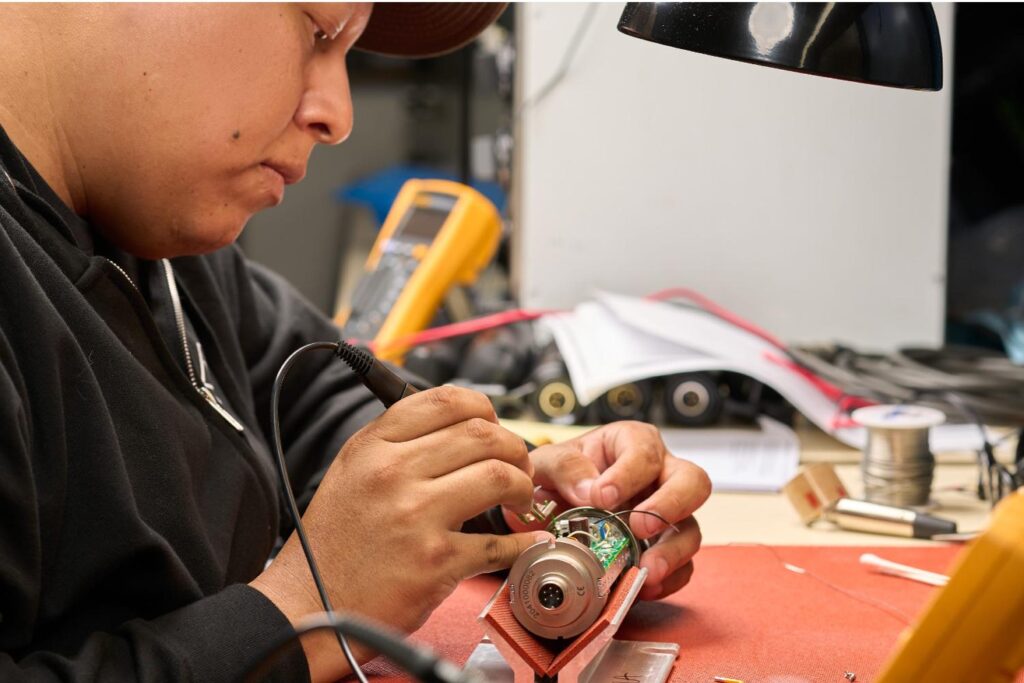Words by Mixdown staff
It’s difficult to know where to begin when two names like this team up in the pro audio world.
Universal Audio (UA) have their fingerprints all over the workflow of the modern studio, having grown to become one of, if not, the biggest names in the production space.
David Bock is known for top quality vintage-styled mics, sourcing parts to make them as close as possible to the originals without the price tag or seemingly constant maintenance required of a vintage mic.

It seems a likely pairing then, that someone of Bock’s ethos should pair up with a company of UA’s standing, with the ability to access the ‘real deal’ mics as well as presenting the opportunity to develop these on a larger scale.
Read all the latest features, columns and more here.
Universal Audio’s recent foray into the transducer world has no doubt been indicative of a brand that has come to define the maturing nature of the prosumer audio boom, for the better part of the last decade. From their revolutionary Satellite and Apollo series, through to their industry leading modelling algorithms in the plug-world, recent high quality, small footprint interface offerings like the UA Volt series and now with their new range of microphones, they are a brand that has always seemed to be a step ahead of market expectations, both in concept and in execution.
From the base model SD-1, designed for podcasting and streaming, through to their SP-1 pencil condensers, as well as their more recent (and truly groundbreaking), Sphere LX and Sphere DLX modelling microphones. Sphere harnesses UA’s unrivalled abilities in providing accurate software models of classic equipment to provide near perfect emulations of 20 of the most coveted microphones in recorded music history. Each UA mic release has something new to bring to the table, catering to an entirely different subset within the broader recording community.
The new Bock range of microphones, which include the UA Bock 167, 187 and now the 251 are an ode to classic analog mic design, albeit with the kind of modern day reliability and build quality required of today’s engineer. While it’s easy to figure out which classics these mics are paying homage to, their accuracy in doing so is startling.
Throughout the 60s, studio recording moved forward in leaps and bounds. Thanks in part to some trailblazing engineers, producers and studios, quality microphones became the standard, offering improved depth, focus and clarity in their response. A handful of renowned German-made microphones pushed the envelope, some known for their unparalleled versatility, making whatever they were used on sound sweeter, clearer and larger than life on playback. These mics are still considered the gold standard for studio recording to this day and are a familiar sight in studios worldwide (vintage, re-issues and clones alike).
Of all the classic microphones released in this era, one particular microphone introduced in 1960 has proved particularly timeless, offering detail and clarity across a larger frequency spectrum, with an inherent musicality that has seen it become the yardstick to which others are measured— the legendary U67.
Having seen countless versions of these German-made mics across his desk over the years, David Bock knows what makes them tick, as well as fail, and uses this knowledge to inform his modern designs.
Take the UA Bock 167 for example, Bock’s version of the famed German mic, which, as we’ve discussed, is commonly used on detailed sources like vocals, drums, acoustic instruments including strings and orchestras, as well as for use as a voiceover mic with depth, clarity and a balanced, honest tone.

David Bock worked as a chief technical engineer at the world’s top studios, so he knows the original circuits back-to-front, as well as their shortfalls; all of this is refined and built upon in the UA Bock 167. Building on from the original’s onboard controls, the UA Bock 167 includes three High Frequency EQ options, cut @ 5 kHz, cut @ 10 kHz, flat response or a boost at 10kHz. The UA 167’s “Fat” switch also provides a low end boost between 10 Hz and 400 Hz, as well as a -10dB pad.
The polar pattern is continuously variable, offering traditional omnidirectional, cardioid, and figure-8 polar patterns and anything in between. Modern additions aside, albeit welcome ones, the UA 167 also employs a NOS EF732 tube just like the original 67s, and a Lundahl transformer.
Other mics in the Bock collaboration also include the UA Bock 187, their take on the classic 87, and the Bock UA 251, a version of the ELA M Telefunken 251 with equally helpful modern additions adding to the otherwise mostly vintage-correct design.
All in all the UA Bock 167 is a meeting of the masters of sorts, David Bock, a seasoned engineer with an unparalleled technical knowledge of one of the most famous circuits in history, and Universal Audio, whose own history is scattered throughout the time that made this circuit so famous.
Universal Audio’s Bock series of microphones acknowledge the benefits of the designs of the originals, but re-appropriate them for the modern day, adding EQ options and contemporary reliability to a tried-and-true design. Sonics are one thing to consider, but reliability in the studio, especially in the middle of a take, are another. Perfect sonics aren’t much help with an artist interrupted by a failing vintage mic, and the UA Bock Series offer you the best of both worlds, plus a few extra tone shaping options. Building on an already stellar range of microphones from Universal Audio, the UA Bock series forge ahead with the flag held high.
Keep reading at UAD.
